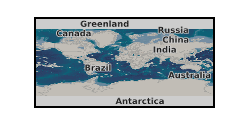Direct testing of forsterite bicrystals via in-situ micropillar experiments at 700 deg C (NERC Grant NE/S00162X/1)
The mechanics of olivine deformation play a key role in long-term planetary processes, including the response of the lithosphere to tectonic loading or the response of the solid Earth to tidal forces, and in short-term processes, such as post-seismic creep within the upper mantle. Previous studies have emphasized the importance of grain-size effects in the deformation of olivine. Most of our understanding of the role of grain boundaries in the deformation of olivine is inferred from comparison of experiments on single crystals to experiments on polycrystalline samples, as there are no direct studies of the mechanical properties of individual grain boundaries in olivine. In this study, we use high-precision mechanical testing of synthetic forsterite bicrystals with well characterized interfaces to directly observe and quantify the mechanical properties of olivine grain boundaries. We conduct in-situ micropillar compression tests at high-temperature (700°C) on bicrystals containing low-angle (4• tilt about [100] on (014)) and high-angle (60• tilt about [100] on (011)) boundaries. During the in-situ tests, we observe differences in deformation style between the pillars containing the grain boundary and the pillars in the crystal interior. In the pillars containing the grain boundary, the interface is oriented at ∼ 45° to the loading direction to promote shear. In-situ observations and analysis of the mechanical data indicate that pillars containing the grain boundary consistently support elastic loading to higher stresses than the pillars without a grain boundary. Moreover, the pillars without the grain boundary sustain larger plastic strain. Post-deformation microstructural characterization confirms that under the conditions of these deformation experiments, sliding did not occur along the grain boundary. These observations support the hypothesis that grain boundaries are stronger relative to the crystal interior at these conditions. This data set is associated with the pre-print manuscript with the DOI: 10.22541/essoar.167979601.17867144/v1

non geographic dataset
:
http://data.bgs.ac.uk/id/dataHolding/13608146
English
Geoscientific information
GEMET - INSPIRE themes, version 1.0:
BGS Thesaurus of Geosciences:
NGDC Deposited Data
Compression tests
Deformation (materials)
Olivine
Physical properties
Free:
Free:
NERC_DDC
creation: 2023-11-06
2019-11-01
-
2021-03-01
University of Oxford
Diana Avadanii
email:
not available
Role: originator
British Geological Survey
Enquiries
email:
not available
Role: distributor
British Geological Survey
Enquiries
email:
not available
Role: point of contact
Data Quality
We investigate two pure forsterite (Fo) bicrystal samples containing a low-angle grain boundary (LAGB, 4◦93 , [100]/(014)) and a high-angle grain boundary (HAGB, 60°, [100]/(011)), respectively. We tilted the bicrystals in a steel mount and polished a surface at 45° 110 to the grain-boundary plane. The surfaces were polished flat using diamond polycrystalline 113 suspensions with grit sizes ranging from 9 μm down to 0.05 μm. Micropillars with nominal diameters of 2–2.5 μm and a height-to-diameter ratio of ∼1:3 were manufactured with a Zeiss-AURIGA Ga+ focused ion beam (FIB) using currents from 2 nA to 50 pA. The micropillars were compressed using a flat-end diamond tip with a nominal diameter of 10 μm. We deformed the micropillars in-situ with a Hysitron PI88 SEM Picoindenter. The in-situ images were captured with a custom TESCAN Mira3 SEM. The mechanical tests were performed at 700◦C.
INSPIRE Implementing rules laying down technical arrangements for the interoperability and harmonisation of Geology
Commission Regulation (EU) No 1089/2010 of 23 November 2010 implementing Directive 2007/2/EC of the European Parliament and of the Council as regards interoperability of spatial data sets and services
Constraints
The copyright of materials derived from the British Geological Survey's work is vested in the Natural Environment Research Council [NERC]. No part of this work may be reproduced or transmitted in any form or by any means, or stored in a retrieval system of any nature, without the prior permission of the copyright holder, via the BGS Intellectual Property Rights Manager. Use by customers of information provided by the BGS, is at the customer's own risk. In view of the disparate sources of information at BGS's disposal, including such material donated to BGS, that BGS accepts in good faith as being accurate, the Natural Environment Research Council (NERC) gives no warranty, expressed or implied, as to the quality or accuracy of the information supplied, or to the information's suitability for any use. NERC/BGS accepts no liability whatever in respect of loss, damage, injury or other occurence however caused.
Available under the Open Government Licence subject to the following acknowledgement accompanying the reproduced NERC materials "Contains NERC materials ©NERC [year]"
licenceOGL
Metadata about metadata
0bc51c9d-10ca-58ac-e063-0937940ae41d
British Geological Survey
Environmental Science Centre,Keyworth,
NOTTINGHAM,
NG12 5GG,
United Kingdom
tel: +44 115 936 3100
email:
enquiries@bgs.ac.uk
Role: point of contact
2024-04-24
